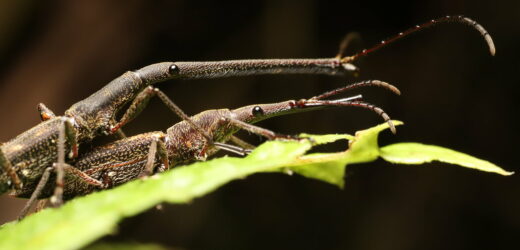The greatest jousting competitions in the world can be found on certain rotting trees in the New Zealand bush, where hordes of males compete for the opportunity to mate. The knights are not humans but New Zealand giraffe weevils, a species of beetle with a snout like a lance. The biggest males snout-wallop each other until the other either retreats or is knocked unceremoniously from the bark.
Competition is especially fierce because male giraffe weevils come in a stunning range of sizes: The largest male weevil is 30 times larger than the smallest. In human terms, this would be like having a friend who was the combined size of two adult giraffes.
As male weevils grow larger, their snouts grow disproportionately long, which would seem to suggest that the biggest males use relatively more energy to wield their enormous heads. Some biologists have theorized that these exaggerated traits are what they call honest indicators of how fit the animal is as a potential mate or competitor; under this logic, a weak elk would not have the energy required to maintain enormous horns.
But a paper published Friday in the journal Functional Ecology reports that the biggest New Zealand giraffe weevils actually use relatively less energy than their smaller-snouted kin, thanks to an energy-saving anatomical hack.
Ummat Somjee, an evolutionary biologist at the Smithsonian Tropical Research Institute in Panama and an author on the paper, was originally studying leaf-footed bugs in an attempt to understand how much energy the bugs spent on their hulking hind legs.
One day, Dr. Somjee came across a decaying log in a Panamanian jungle that was teeming with jousting weevils. “It was like a little war zone on the log,” Dr. Somjee said. (The Panamanian species is depicted in the tweets embedded below.)
Dr. Somjee learned those weevils had an even stranger cousin, the New Zealand giraffe weevil. The enormous gulf in sizes between male adult New Zealand giraffe weevils made the species an ideal candidate to investigate the energy costs of a range of snout sizes.
He reached out to Chrissie Painting, a behavioral ecologist at the University of Waikato in New Zealand and an author on the study, who started studying the weevils in 2009. In 2019, Dr. Painting led Dr. Somjee to her secret collecting spot, which she calls “weevil city.”
If startled, a New Zealand giraffe weevil will hurl itself from a tree. To collect weevils en masse, Dr. Painting held an ice cream container under the tree, waved her hand, and watched as the weevils simultaneously backflipped into the container.
Back in Dr. Painting’s lab, the researchers measured the metabolic rates of their potpourri of weevils. They placed the weevils into sealed glass syringes — their long bodies seemed bespoke for the tubes — and measured their oxygen depletion at rest. They also placed the weevils on tiny treadmills to measure energy spent on a quick trot. Both results revealed that larger weevils used less energy per gram of tissue than smaller weevils did. In other words, 30 small weevils would use considerably more energy than the biggest weevils, which are the size of 30 small weevils.
These results might seem confusing — wouldn’t a pole-headed male weevil use much more energy? The researchers beheaded their weevils, dried the heads in an oven and placed them in a solution to digest living tissue but preserve the cuticle, an inert hard tissue.
They found that larger male weevils have snouts and legs that contain increasingly more cuticle and less metabolically active tissue than smaller males do. “It’s kind of a really cheap way to get bigger,” Dr. Somjee said. In fact, the largest males, the smallest males, and females all dedicated approximately the same percentage of their snout to soft, energy-sapping tissues.
The researchers compared their own metabolic data to a range of other insect species, as there was no other insect with such a breadth of size. The pattern they found in their own data, that larger weevils used relatively less energy per gram of tissue, was consistent across species.
Douglas Emlen, a biologist at the University of Montana who was not involved with the research, says the new paper validates the longstanding theory that exaggerated weapons are honest traits; for example, a bigger snout means a stronger weevil.
But the new research also shows that weapons are disproportionately costly to small males, Dr. Emlen said.
“We all focus on the really big males,” he said. “But what matters is whether the little guys can fake it.” They cannot, he adds, and that makes a big snout an honest signal of a weevil’s hunky physique.
Adult weevils do not grow. “If you emerge as a small male, there’s no going back,” Dr. Painting said. So the smallest weevils have developed an alternative mating strategy to compensate for their stubby sniffers: They sneak under bigger males to mate with females. But they are still not as successful as their bigger rivals and also die younger, Dr. Painting said.
Midsize weevils also have a rough go of it, too small to joust and too large to sneak.
“There’s nothing fair about nature,” Dr. Emlen said. “The wealthy get wealthier and the poor get poorer.”
Alas, the beetles who got the short end of the snout seem to truly be the lesser of two weevils.
Source: Read Full Article


